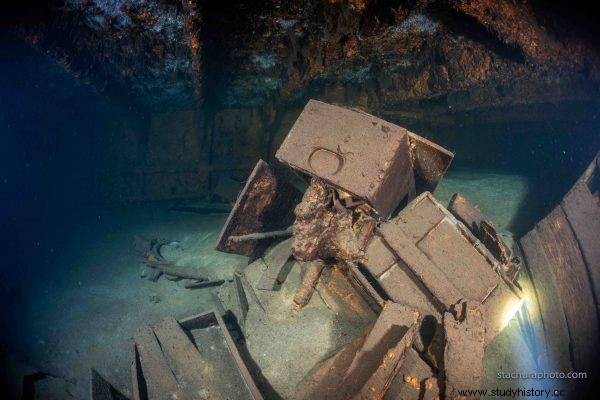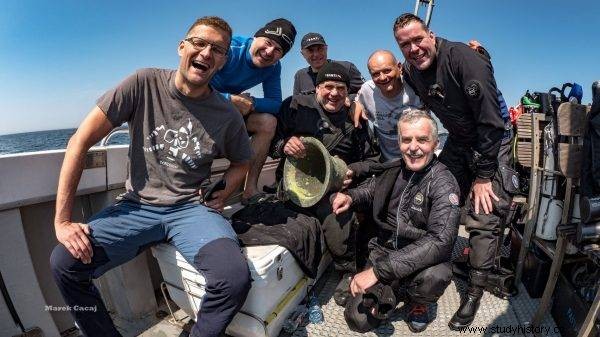When a terrible roar shook the 66-meter-long steamboat, many passengers knew what had happened - Soviet planes had reached their destination. A bomb ripped a hole in the side of the ship. Frightened people tried to save themselves, but the element was pressing from everywhere. Karlsruhe only went to the bottom three minutes. He took nearly 1,000 people with him. 360 tons of cargo were also sunk - including perhaps one of the most valuable treasures in the world, the Amber Room ...
Karlsruhe went down on April 13, 1945. It was one of the last German ships with East Prussian refugees on board before the Red Army took over the area.
Underwater Cemetery
On January 20, 1945, under the order of Admiral Karl Dönitz, the Germans launched Operation Hannibal - an unprecedented in scale evacuation of the German army and population by sea from Gdańsk Pomerania, Courland and East Prussia, to which the Soviet forces were approaching. The escape was a fight for life. Civilians in Prussia would face rape and murder. The Red Army soldiers had a good reason to kill - it was supposed to be a retaliation for German crimes in the USSR. The operation lasted until the end of the war. During this time, the Nazis redeployed about 2 million people to the West.

Karlsruhe
“It was the largest sea evacuation ever to occur. 1080 units were used. Of these, 247 never reached their destination. The Baltic Sea has become their grave. About 100 wrecks were recovered after the war, the rest is still at the bottom "- explains Tomasz Stachura, Karlsruhe wreck discoverer, Hannibal history enthusiast, diver, photographer, leader of the Baltictech diving team.
Although Operation Hannibal may be considered a success, thousands of casualties could not be avoided. To this day, in the depths there are the remains of powerful cruise ships and transport ships sunk by the Russians. The Polish authorities granted the three largest wrecks the status of war graves.
On January 30, 1945, the mighty cruise ship "Gustloff" set out on its last voyage. The ship went to the bottom at the level of today's Łeba. Only 900 of the nearly 10,000 passengers were saved. The Nazis were so frightened by the tragedy that they concealed the number of victims. Soon after, the fate of "Gustloff" was shared by the transport ship "Stauben" with 3,500 people on board. In turn, in April 1945, a dozen or so nautical miles north of Rozewie, the transport ship "Goya" sank (about 200 out of 7000 people survived). 
The sinking of the Karlsruhe steamer is also one of the greatest tragedies of Operation Hannibal. “Unlike other large units, we did not know where Karlsruhe was so far. Therefore, we undertook the task of finding him - and we succeeded - explains Tomasz Stachura.
Death in the Deep
The steamer Karlsruhe was already 40 years old when it set out on its last voyage, so it was a worn-out machine. On April 12, 1945, the 66-meter ship left the port in Piława (today's Baltiysk) near Królewiec (now Kaliningrad). It was supposed to reach today's Świnoujście. Tomasz Stachura says:
We got to the documents which show that originally - according to the instructions of Admiral Karl Dönitz - only soldiers from the Hermann Goering regiment and 360 tons of the mysterious cargo were supposed to sail on the ship " return goods " . Most likely, however, as a result of the pressure from the civilian population, over 1,000 people were on board. The evacuation was carried out in a hurry . 
A total of 1,063 passengers were counted, including 150 soldiers from the Hermann Goering regiment, 888 refugees and 25 railroad workers. Stachura describes:
On April 12, the ship arrived at Hel, where a strong escort joined the steamer:4 freighter and 3 escort. The convoy continued its journey at night. It was a deliberate action to escape the Russians. This, however, did not work. On the morning of the second day, the convoy was spotted by the pilot of a Soviet reconnaissance plane. About an hour later, the first combat group:3 A-20 bombers (originally Douglas DB 7 aircraft - delivered to the USSR by the US) and 2 Yak-9 fighters started the attack .
There was an exchange of fire. The convoy managed to defend itself and even shot down one machine, which caused great joy. The euphoria, however, was premature. “A few minutes later, a second combat group of Soviet planes flew over the German ships. Karlsruhe was immediately targeted. A half-ton bomb ripped off his port side. It was a swift end to a mighty ship. The steamer had no partitions between the holds, so the water took the vessel in seconds, ”explains the discoverer. Most people didn't even get on board, she adds:
Karlsruhe only drowned three minutes. The water overloaded the ship, which went to the bottom with its bow vertically, taking with it nearly 1000 passengers. They were simply dragged to the bottom with the ship. Many did not manage to leave the cabin .
Karlsruhe hit the bottom with his beak. As a result, the front of the ship curled up like a harmonica. The vast majority of the cargo he was carrying had shifted forward. Today, in the depths of the Baltic Sea, 88 meters deep, these people have left a huge amount of shoes and leather belts. However, there is no trace of the bodies. There are single bones.
A chamber in the Baltic Sea?
Members of the Baltictech group informed the public at the end of September 2020 that they had found the wreckage of a steamer. Karlsruhe sank several dozen kilometers north of Ustka. It was possible to establish this on the basis of the reports of the Radzice pilots. Divers scanned a 200-meter-wide strip of seabed and found a shape that corresponds to the sunken vessel. "Three dives deep into the Baltic Sea confirmed without any doubt that this is the ship," says Stachura.
In the interior of the steamboat, the discoverers found, among others remains of the military equipment of the victims, boots, helmets, belts, weapons, porcelain and many locked chests and military cars. As Stachura emphasizes:
There are several indications that it was this ship that could have brought one of the most valuable treasures in the world from Konigsberg - the Amber Room . Just before her disappearance, she was in Królewiec. Apparently, at the end of the war, the Germans took it away and hid it, but it was not found in other sunken ships. 
The Amber Room, i.e. a complete palace decor made of amber by Gdańsk masters, was donated by the Prussian king Frederick William as a gift to Tsar Peter the Great. During the war, the Nazis stole it from the palace in Tsarskoye Selo near St. Petersburg. She went to Królewiec. Until 1945, it was hidden in chests in the basement of the Königsberg castle. What happened next? It is not known, but when the Russians captured Królewiec, they did not find the treasure. Stachura explains:
The removal of the chamber from Konigsberg could have been ordered by Erich Koch, the East Prussian gauleiter. Koch was a staunch opponent of the evacuation from East Prussia. Until the end, he believed that the Germans would defend themselves. He was not a model of the German order - he only evacuated his own property at the last moment; packed it on the train. The Russians found him on a railway siding.
If this is what he did with his belongings, who knows if he didn't remember the room at five to twelve as well. Karlsruhe was the last ship to escape from Piława. If the treasure had not been taken away before, and it would have been known by now, this steamer is at stake .
The large number of mysterious crates that the Polish group found in the wreck is puzzling, as well as the fact that the ship had a strong escort and also carried cars, as if it was going to continue its journey by land after reaching its destination. What next with a sensational discovery? Will it be possible to check what is hidden in the mysterious chests?

The full Baltictech team
The divers explain that their role was over when they got to the ship and made photo and film documentation. “As a private team, we have neither the right nor the physical ability to work in the depths of . The ship is located in the area of the Polish economic zone, which gives the Polish side certain rights. I hope that action will be taken and the secret of Karlsruhe will be clarified " - says Stachura. He and his colleagues are not fame as explorers. They also don't try to hit the drum with media hype:
Smart action is needed here. We do not want Karlsruhe to become the second golden train. Unlike the latter, we know the ship does exist. We have been there, we have seen. Is there a priceless treasure inside? This must be checked.
